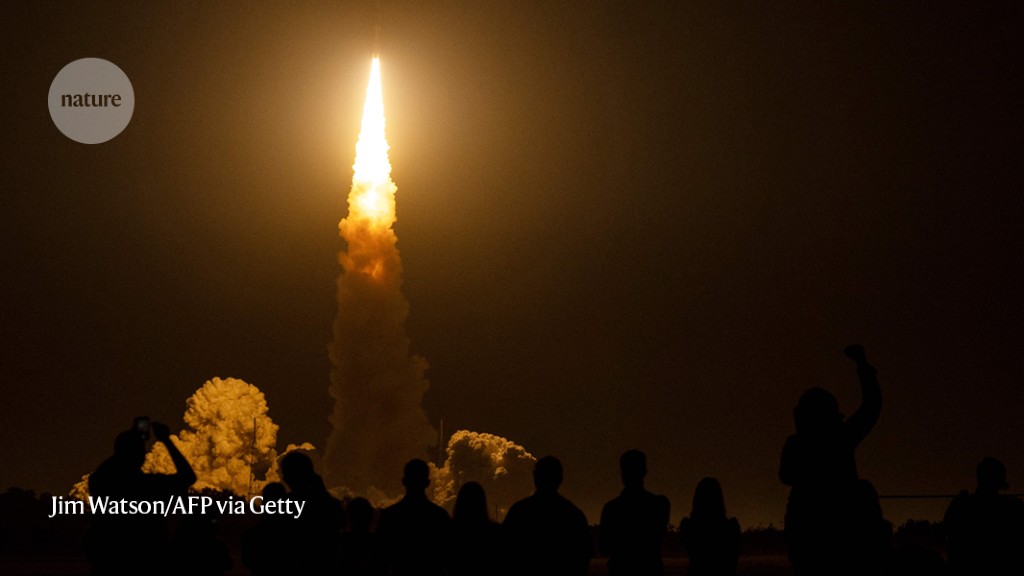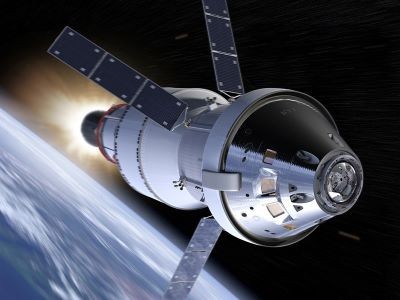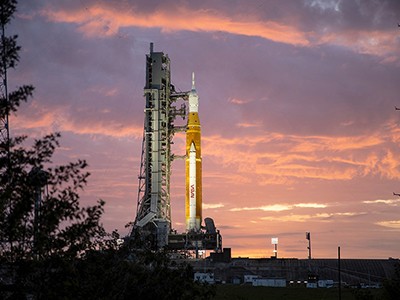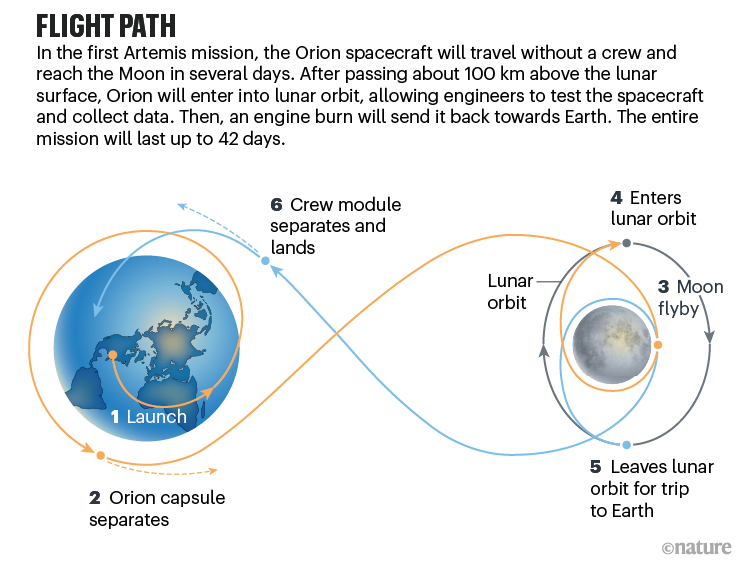The Artemis 1 launch paves the way for a future human mission to the Moon.Credit: Jim Watson/AFP via Getty
NASA’s huge new rocket blasted off from Kennedy Space Center in Florida at 1:47 a.m. Eastern time today, achieving a major milestone in the agency’s plans to send astronauts back to the Moon.
“We rise together, back to the Moon and beyond,” said NASA launch commentator Derrol Nail as the mighty rocket thundered into the night skies above Cape Canaveral.
The launch put an uncrewed astronaut capsule, called Orion, into Earth orbit and towards a planned course to fly past the Moon and back over the next 26 days. The flight, known as Artemis I, will test whether the rocket and capsule will be able to transport humans safely, while carrying a number of scientific experiments.
NASA’s Artemis Moon mission is set to launch: here’s the science on board
This is the first time in half a century that NASA has flown a rocket powerful enough to send humans beyond low Earth orbit.
The flight was delayed after two attempts in late August and early September, which were cut short owing to hardware problems, including leaks of liquid hydrogen fuel. NASA then passed on a launch opportunity in late September because of an approaching hurricane, before putting it back on the launch pad, where it experienced high winds and rain from a different storm last week. NASA managers say that storm caused only minor damage to the rocket, including peeling off a strip of caulking that they say will not endanger the launch.
The delays mean that several of the small solar-powered satellites that are flying on Artemis I, which will be deployed into space to conduct research, have not had their batteries charged in more than a year. “We believe most of the secondary payloads are going to be able to power up and boot up once deployed,” says Jacob Bleacher, NASA’s chief exploration scientist. “We’re just going to have to see once they get up there and released out into orbit.”
A symbolic start
For many researchers, Artemis I represents the symbolic start of a new era of US lunar exploration. NASA named this and subsequent planned flights Artemis in homage to the Apollo programme that sent 12 astronauts to the lunar surface between 1969 and 1972. In Greek mythology, Artemis is the goddess of the Moon and twin sister to the Sun god Apollo.
With the Artemis programme, NASA aims to establish a long-term presence on the Moon. That will begin with a series of robotic landers starting early next year, followed by astronauts landing at the lunar south pole no earlier than 2025, and the establishment of a lunar space station and base after that. If NASA is successful, part of the historical significance of Artemis will be that sustained presence, says Teasel Muir-Harmony, a historian at the Smithsonian Institution’s National Air and Space Museum in Washington DC.
If Artemis III lands astronauts at the lunar south pole, they will probably collect Moon rocks, as shown in this artist’s rendering.Credit: NASA
Science will also benefit. Astronauts landing on the Moon will be studying ice hidden in the shadowed craters at the never-yet-explored lunar south pole. That means collecting Moon rocks, which the United States has not done since the last Apollo mission in 1972. Analysis of lunar rocks at the south pole could reveal secrets of the early Solar System that scientists have long been hoping to crack. “We’re dying to get down to the surface and bring those rocks back,” says Brett Denevi, a lunar researcher at the Johns Hopkins University Applied Physics Laboratory in Laurel, Maryland. “We’re on the precipice of something really exciting.”
But there’s a lot of uncertainty. Several US presidents previously tried to set NASA on a path to return to the Moon or send humans to Mars, but because of budget cuts and shifting priorities, the agency has not managed to take those steps until now. “There’s the scepticism and cynicism of, is this really going to happen?” Denevi says.
Back to the Moon
After the Apollo programme ended, NASA focused on building and flying the space shuttle, which operated between 1981 and 2011, and constructing and working aboard the International Space Station, which has been permanently occupied since 2000.
The $93-billion plan to put astronauts back on the Moon
Space experts have been waiting for another big lunar launch for a long time. “As a child of Apollo, I never believed I’d see this,” says David Parker, director of human and robotic exploration at the European Space Agency in Noordwijk, the Netherlands.
“It’s making it real, that we’re going back to the Moon,” adds Chiara Ferrari-Wong, a lunar scientist at the University of Hawaii at Manoa. “It’s all feeling very real now.”
Artemis I is meant to be a basic check of engineering systems. “If history is any indicator, it doesn’t have to be a flawless flight,” Muir-Harmony says. The equivalent flights in the Apollo programme revealed problems that needed to be fixed: for instance, Apollo 6, an uncrewed flight of the Saturn V rocket in 1968, experienced oscillations soon after launch.
During the Artemis I flight, the Orion capsule will head to what’s called a distant retrograde orbit around the Moon. That will take it around 64,000 kilometres past the Moon, travelling in the opposite direction to the Moon’s orbit of Earth. Throughout the journey, mission controllers will test how the capsule responds to flying in deep space. Orion will eventually leave that orbit and head back towards Earth, splashing down in the Pacific Ocean off San Diego, California (see ‘Flight path’).
Source: This graphic was repurposed from this story, by Alex Witze.
If all goes well, the next launch of the rocket, in a mission known as Artemis II that will happen no earlier than 2024, will carry four astronauts around the Moon. The crewed landing, Artemis III, will follow. Each launch is estimated to cost at least US$4 billion.
But many steps remain before those flights become reality. Most significantly, the aerospace company SpaceX in Hawthorne, California — which NASA has contracted to supply a crewed lunar lander called Starship — will need to demonstrate that the giant ship is capable of carrying astronauts from lunar orbit to the Moon’s surface. So far, Starship has been tested only on the ground, although it could attempt its first orbital flight in the coming months.
There’s science to be done
NASA has pledged that at least one of the two Artemis III astronauts who will step onto the lunar surface will be a woman. The pair will probably stay on the Moon for around 6.5 days, venturing out of Starship to conduct various scientific experiments, including collecting rocks.
These six countries are about to go to the Moon — here’s why
Their exact landing site has yet to be chosen, although in August NASA announced a shortlist of 13 regions around the lunar south pole.
One spot researchers want to investigate is the largest crater on the moon, the South Pole–Aitken impact basin, created by an ancient collision. Getting rock samples from the crater would allow researchers to pinpoint when the collision occurred, thus anchoring a key point in the history of the early Solar System. Some of the potential Artemis III landing sites might contain rocks tossed out by the ancient collision.
Well before astronauts arrive, however, a host of robotic Moon missions are slated to take place. A series of landers built by US commercial companies will ferry scientific instruments and other payloads to the lunar surface. The first of these will happen no earlier than the beginning of next year, and will head to a volcanic plain in the Moon’s northern hemisphere known as Lacus Mortis, carrying experiments including several that will measure the chemistry of the lunar soil. Another, much-anticipated, delivery will be a rover that is scheduled to go to the south pole in 2024 to drill for ice.
For Ferrari-Wong, NASA’s return to the Moon represents a broader cultural touchstone that resonates with both scientists and members of the public around the world who gaze up at the Moon every night. “What I love about studying the Moon, and what’s so exciting about Artemis, is that it’s symbolic to almost everyone,” she says. “It’s also the next step to the rest of the Solar System. That’s just amazing.”













More News
Star Formation Shut Down by Multiphase Gas Outflow in a Galaxy at a Redshift of 2.45 – Nature
Garden-variety fungus is an expert at environmental clean-ups
Air-travel climate-change emissions detailed for nearly 200 nations